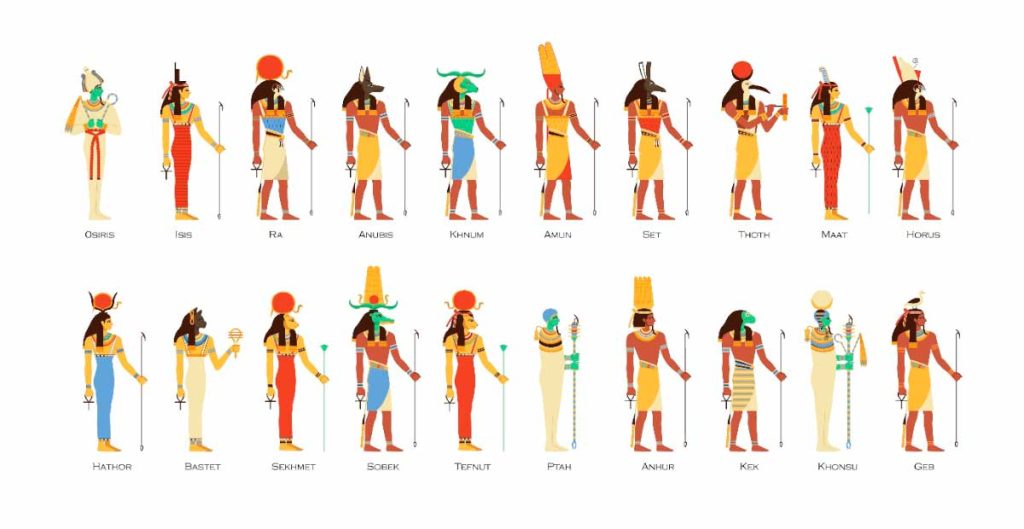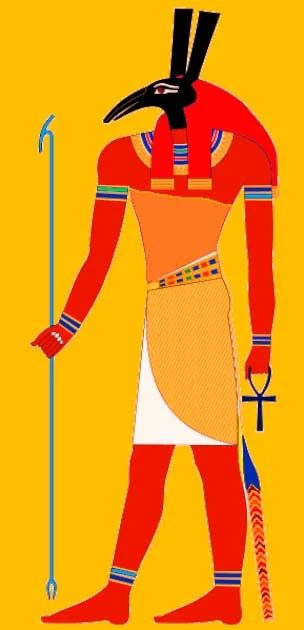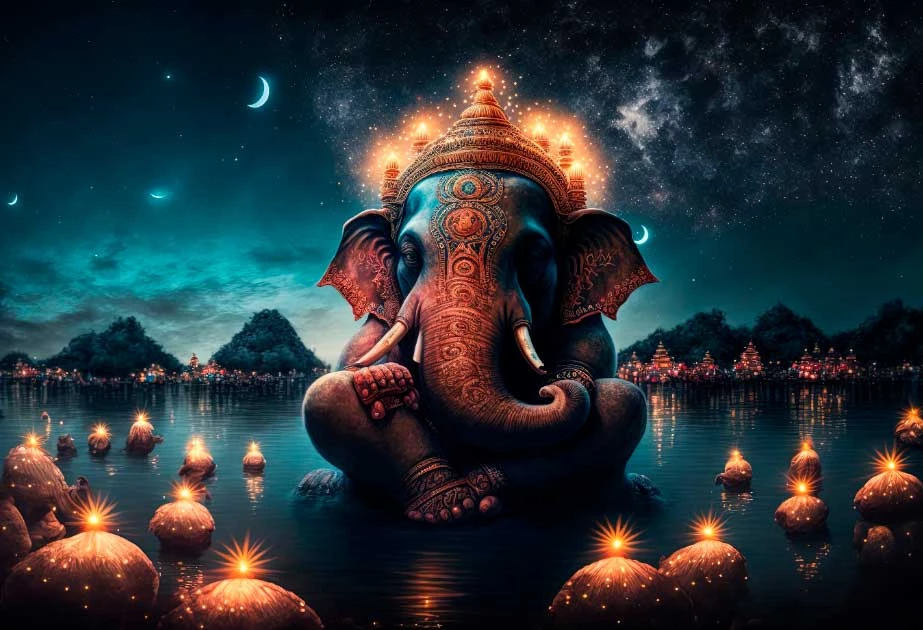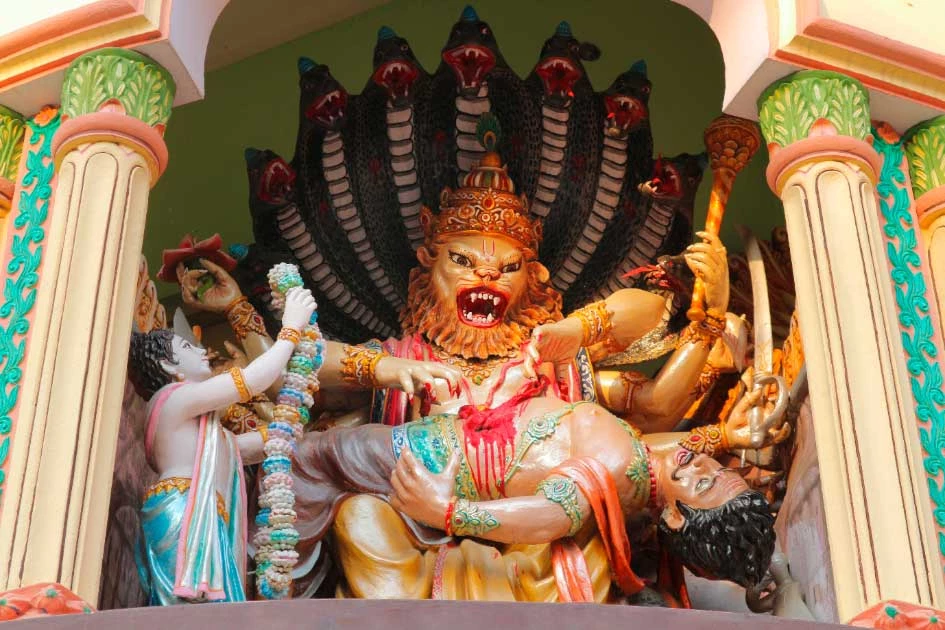Many religions have deep roots in mythology. Many gods and goddesses represent natural phenomena and nature, good or evil, life and death, and more. We are all very familiar with the Greek and Roman mythological pantheons, but what about others?
Consider the gods and goddesses of ancient Egypt and Hinduism. While the characters are all different and unique, both religions have something in common besides polytheism: their gods are drawn from the animal kingdom.
More specifically, these are animal-headed gods and goddesses. These animal gods often have the body of a human and the head of an animal which usually relates to their personalities and powers. Were the ancient Egyptians and Hindu writers connected in any way? Are there gods that both faiths share?
Egyptian Animal Gods
The Egyptian pantheon is one of the most recognized examples of animal gods and goddesses. There are several animal gods, each with unique features, skills, and representations.
One of the more prominent is Horus, a sky god associated with war and hunting. During some eras, the current king or pharaoh was considered to be the human manifestation of Horus. Horus is depicted as either a falcon or a man with the head of a falcon. Three other avian-headed animal gods exist: Re, Thoth, and Khonsu.

Re, perhaps more familiar as “Ra” is the god of the sun, depicted as a man with the head of a hawk. During the day, Re sails in a boat across the sky in the form of the sun. Each night, Re passes through the underworld and dies. Each morning Re is reborn in the form of the sun rising in the sky.
Then there is the animal god Thoth, a man with the (tiny) head of an ibis. Thoth was the god of writing and knowledge, and he played a role in the journey a soul takes once they have died. Thoth is seen in the Book of the Dead, recording the deeds of the dead on the day of judgment.
Khonsu was the god of the moon with the power to drive away evil spirits and had the body of a man and the head of a falcon. You will know you see Khonsu and not Re because Khonsu wears a headdress with a crescent moon holding an entire lunar disk.
The next animal god in the Egyptian pantheon is Anubis, a man with the head of a jackal. Anubis plays a prominent role in the book of the dead. This is because Anubis is the protector of the dead and is associated with mummification. Anubis leads the deceased to and through the hall of judgment.
Another animal god is Khepre, who appears as a man with a scarab beetle as a head or he is a scarab beetle. Khepre was believed to roll the sun across the sky like a dung beetle rolls a ball of dung around. Then there is the animal god Sobek, the god of the crocodiles. Egypt is known for its crocodiles, and Sobek, a man with the head of a crocodile, protects and rules them.
- The Ogdoad: When Amun Ruled the Gods of Egypt
- Vimanas, The Hindu Machines: Did Ancient India Have Flying Saucers?
One of the last male animal-headed gods is Seth. Seth is the god of darkness, a figure eventually defeated by Horus to the gods’ and mortals’ delight. Seth comes in many different forms of animals and is depicted with the body of a man and an “unknown animal head.”

This animal god can also appear as a hippo, a rhino, or a donkey. The final three animal gods from Egypt are Bastet, Tefnut, and Sekhmet, which all have a woman’s body. Bastet is a woman with the head of a cat and the goddess of pleasure. Many cats lived at her temple in Bubastis and would be mummified once they had died.
Tefnut is a woman with the head of a lioness and was one of the first gods created by Atum. She is the goddess of rain, moist air, and dew. The final animal god is Sekhmet, who has a woman’s body and a lioness’s head. Sekhmet differs from the other lioness-headed goddess Tefnut because Sekhmet is the goddess of the desert sun, war, chaos, plague, and healing.
Re created this goddess as a weapon to vanquish disobedient humans. While she can bring a plague upon the land, she can also avert the plague and cure diseases.
Hindu Animal Gods
India and Egypt are over 3,060 (4,931 km) apart, yet both faiths have animal gods and there are some unexpected similarities. One Hindu animal god is Nandi, The Gatekeeper of Kailash. This god associated with the sacred and divine bull has the body of a man with the head of a bull; he may also be depicted as having four arms.
Nandi stood guard at Kailash, where Lord Shiva lived, and bulls are notoriously stubborn and strong, a perfect gatekeeper. Nandi is unique because he is Lord Shiva’s chief attendant and vahana. A vahana, which literally translates to “that which carries, that which pulls,” is an animal that a Hindu god uses as a vehicle.
The next Hindu animal-headed god is Garuda, The King of Birds. Garuda represents birth and heaven and is a man with the head and wings of an eagle. His body is gold except for his face, which is white, and his wings, which are red.
More than just an animal god, Garuda is the vahana of Lord Vishnu in the form of an eagle. In some texts, Garuda represents strength and vigilance.
Then there is Hanuman, The Monkey God. Hanuman has the body of a man with the head of a monkey and a tail. Hanuman is a demigod and represents wisdom, strength, courage, devotion, and self-discipline. He never claimed his godly status and was a devoted servant of Lord Ram, and his personality led him to become one of the most loved gods in Hinduism.

Another well-known and recognizable Hindu animal god is Ganesha, The Elephant God. With the body of a man and the head of an elephant, Ganesha is the god of intelligence and a “remover of obstacles”.
The animal god Narasimha, The Lion Man, is a significant figure in the Hindu pantheon. Narasimha is the fourth avatar of Lord Vishnu. An avatar is a concept that signifies the physical appearance or the incarnation of a powerful deity. In the Mahabharata, Vishnu states that he will appear as Narashima, the fourth of his ten incarnations.
Another god who is considered to be one of Vishnu’s avatars is Hayagriva, The Horse-necked One. Hayagriva has the body of a man with the neck and head of a horse and four arms. Each of his arms serves a purpose.
One arm is for bestowing knowledge; one arm is for holding the Vedas (books of wisdom); and the final two arms are for holding a conch shell and a gold discus. He is considered to be the god of knowledge and wisdom and symbolizes the victory of knowledge “over the demonic forces of lust and darkness”.
The final animal god is Kamadhenu, The Miraculous Cow. Unlike the other animal gods discussed above, Kamadhenu is a female god and the only animal god with a human head. She is depicted as a white cow with wings and the head of a woman. Kamadhenu represents generosity and abundance because she is said to provide her owner with anything they desire. While she is a goddess, she is not worshiped at a temple or has a role in any ritual or ceremony.
Connections?
Both the Egyptian and Hindu pantheons have animal gods; both faiths have some similarities. When it comes to animal gods, they all are examples of therianthropes or beings who have the gift or curse of the ability to shapeshift into an animal or animal hybrid.
Another example of therianthropic transformation is the ability of the Valkyries from mythology to shed their swan skin and appear as a woman. These human-animal hybrids can be found in mythology and folklore across the globe.
Animal gods in ancient Egypt and Hinduism present themselves to mortals in a form that expresses their powers and personalities. The Egyptian goddesses, Tefnut and Sekhmet, are depicted as lionesses with human bodies and have the characteristics and personalities of a lioness.

Both goddesses were known to be wrathful and strong figures, much like a lioness who would defend her cubs at all costs and do all the hunting for the pride. In Hinduism, we have another lion-headed god, Narasimha, the fourth avatar of Lord Vishnu. Narasimha symbolizes great power, and the lion rules over the entire pride.
There are also several avian-headed gods in the Egyptian and Hindu pantheons. Horus, Re/Ra, Khonsu, and Thoth are all animal gods depicted as human males with the head of a bird. In Hinduism, there is Garuda, the King of the Birds, and the vahana of Lord Vishnu.
While the bird-headed gods seem very different, the powers of the Egyptian gods can be found in Garuda. Hunting, the divine, life, and knowledge (Garuda is sometimes the literal embodiment of the idea and the self) are what the avian gods represent.
Ultimately, trying to tie the animal gods of the Egyptian and Hindu pantheon together or compare them does a disservice to the unique cultural, religious, and significance each god represents. To say there is a direct connection or that the animal head deities are related is a bit of a reach… a 3,000-mile-long reach.
These are animals found in the areas ancient writers lived in and were creatures even illiterate people could recognize in iconography. It seems that both pantheons simply come from observing the world around them.
Top Image: The Egyptian sun god Re with the head of a hawk, one of the many animal gods in the Egyptian pantheon. Source: Vladimir18 / Adobe Stock.